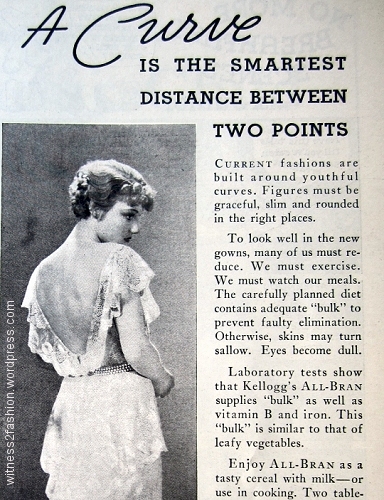
“You’d never guess they once called me SKINNY.” Ad for ironized yeast, 1934. Breasts are prominently featured.
Nineteen thirties’ fashion illustrations show tall, impossibly narrow-hipped women, but magazines also ran ads humiliating women for being “too skinny.” Sometimes I encounter an “Are you too fat?” ad, turn the page, and encounter an “Are you too skinny?” ad. One explanation is that, in times of famine, looking too thin implies poverty and hardship. And many people really did go hungry in the 1930’s.
(In modern America, cheap, poorly nutritious food — a tasty and addictive combination of fats, carbohydrates, salt and sugars — has created a historically unique situation: now, obesity is often a sign of poverty, while a lean, fit body is a sign of wealth and leisure: it signals enough money to afford fresh foods, along with time — and a safe place — to exercise.)
Certainly the emphasis on a “boyish” figure favored the young and slender in the mid-nineteen-twenties.
But 1933-1934 was a time of mixed signals for the average woman.
“How would you like to lose 15 pounds of fat in a month…?” That was on page 81.
Or maybe you should gain 15 pounds? The following ad was on page 97 of the same magazine:

Delineator, March 1933, page 97. “Dangerous to be skinny.” Ad for Ironized Yeast, which “adds solid, healthy flesh quicker than beer.”
“I’m so lonely and unhappy. Nobody likes a skinny girl.”
“There’s no need to be skinny now. I’ll tell you a quick way to gain.”
“New discovery adds solid, healthy flesh quicker than BEER…. For years doctors prescribed beer to put flesh on these scrawny, weak, nervous people.”
The ad urged readers to compare their weight and measurements with the “solid, healthy” model on the left.
“Selected as having the best figure in the U.S. for her height, according closely to measurements favored by a famous theatrical producer and a great artist.” [Both anonymous…. She’s a long way from the 1930’s fashion illustrators’ ideal!]
The same Ionized Yeast company offered different models’ measurements in each ad:
“Skinny girls listen to this! … Adds pounds quicker than beer.”

May, 1934 Ionized Yeast ad. “Now no need to be thin…. New easy way adds pounds so fast you’re amazed.” The model’s measurements are given as 35″-26″-36.”
Six weeks ago she was jeered at, but Ionized Yeast “gives 5 to 15 lbs. in a few weeks.”

June, 1934 Ionized Yeast ad. “…Get lovely curves fast!” The model’s measurements are height 5’5″, weight 130 lbs., 35″-27″-38″.
In some of these ads, “curves” seems to be code for “full breasts.” By modern standards, the models are all well within the range for a healthy BMI [Body Mass Index], which cannot be said for many of today’s fashion models. On the other hand, it’s hard to imagine most of these women being chosen to model slinky 1930’s dresses like these:

Ads for Kruchen Salts, sold for weight loss. Delineator ads from May and April, 1933. The word FAT is dominant.

“Ginger Rogers is just the type to wear this difficult but delightful gown.” Ad for Kellogg’s All Bran, Delineator, April 1934. “Watch your figure. Modern fashions are built around youthful curves.”
(If you didn’t recognize her, remember that Ginger Rogers was called “Ginger” because she had red hair.)
Laxative salts were advertised for weight loss, as were breakfast cereals. “Two tablespoonfuls [of All-Bran] daily are usually sufficient…. Isn’t this better than risking unpleasant patent medicines? Kellogg’s All-Bran is not fattening.”
“Figures must be graceful, slim, and rounded in the right places…. To look well in the new gowns, many of us must reduce. We must exercise. We must watch our meals.”
There’s no promise that Corn Flakes will help you lose weight, just the suggestion of lightness.
However, the cover of the July 1933 Delineator shows the appeal of sugary temptations.
Ounce for ounce, ice cream will also “add pounds quicker than beer.” Alas.
True story: A hand-lettered sign appeared taped to a lamppost in my neighborhood: “I LOST 40 lbs of ugly fat! Call: (it gave a phone number.)” The next time I passed, someone had added a smaller sign: “Found @ corner of Sunset & 37th: 40 lbs of ugly fat. Call (a different phone number) to claim.”








